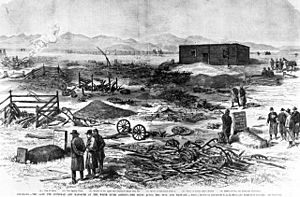Ute Wars facts for kids
Quick facts for kids Ute Wars |
|||||||
|---|---|---|---|---|---|---|---|
| Part of the American Indian Wars | |||||||
 An etching that appeared in the December 6, 1879 edition of "Frank Leslie's Weekly" depicts the aftermath of the Meeker Massacre. |
|||||||
|
|||||||
| Belligerents | |||||||
|
Ute: Ute Allies: |
|||||||
| Commanders and leaders | |||||||
| Walkara Antonga Black Hawk Kanosh Ouray Polk Posey † |
|||||||
The Ute Wars were a long series of conflicts between the Ute people and the United States. These events took place over many years, starting in 1849 and ending in 1923. They happened in areas that are now Colorado, Utah, Arizona, and New Mexico. These conflicts were part of the larger American Indian Wars.
Contents
Understanding the Ute Wars
The Ute Wars involved different Ute groups, like the Yamparika and Weminuche, fighting against the United States. The main reason for these conflicts was the increasing number of American settlers moving onto lands where Ute people had lived for centuries. As more settlers arrived, they often wanted the land for farming, mining, or building towns. This led to disagreements and fighting over resources and territory.
Early Conflicts and Land Disputes
The first major conflicts happened in the mid-1800s. As settlers moved into Ute lands, tensions grew.
The Battle at Fort Utah (1850)
One early conflict was the Battle at Fort Utah in 1850. This fight happened near what is now Provo, Utah. It involved Ute people and Mormon settlers. The conflict started over disagreements about land and resources. It led to a battle where many Ute people were killed.
Walker War (1853–1854)
The Walker War began in 1853. It was named after Chief Walkara, a Ute leader. This war was mainly fought in Utah. It started because of disputes over trade, land, and the treatment of Ute people by settlers. The fighting lasted for about a year.
Tintic War (1856)
The Tintic War in 1856 was another conflict in Utah. It involved Ute groups and settlers. Like earlier wars, it was about land and resources. These early wars showed how difficult it was for different groups to share the land peacefully.
The Black Hawk War (1865–1872)
The Black Hawk War was one of the longest and most serious conflicts. It lasted from 1865 to 1872. This war was led by Chief Antonga Black Hawk. It involved many Ute bands and their allies fighting against settlers in Utah. The war caused a lot of hardship for both sides. It resulted in many deaths and the loss of Ute lands.
The White River War (1879)
The White River War in 1879 was a very important conflict. It happened in Colorado. This war is also known for the Meeker Massacre.
Events Leading to Conflict
Nathan Meeker was an Indian Agent for the Ute people. He tried to change the Ute way of life. He wanted them to become farmers and give up their traditional hunting. He also tried to make them send their children to school. These changes were very unpopular with the Ute people. They felt their culture and way of life were being threatened.
The Meeker Massacre
Tensions grew very high. In September 1879, Ute warriors attacked the Indian Agency. They killed Nathan Meeker and several of his employees. This event became known as the Meeker Massacre. At the same time, another group of Ute warriors attacked a U.S. Army unit. This unit was led by Major Thomas T. Thornburgh. Major Thornburgh and many of his soldiers were killed in the fighting.
Aftermath of the White River War
The White River War led to a major change for the Ute people. The U.S. government decided to move the White River Utes from Colorado to a new reservation in Utah. This move was very difficult for the Ute people. It meant leaving their ancestral lands behind.
Later Conflicts and the Posey War
Even after many Ute people were moved to reservations, conflicts continued.
Beaver Creek Massacre (1885)
The Beaver Creek Massacre happened in 1885 in Colorado. This event involved Ute people and white cattlemen. There were disagreements over cattle. In a gunfight, six Mountain Ute Indians were killed. This was one of the last major fights between Ute people and white settlers in Colorado.
The Bluff War (1914–1915)
The Bluff War took place in Utah from 1914 to 1915. It involved Ute and Paiute people. This conflict was about land and resources. It showed that tensions still existed even in the early 20th century.
The Posey War (1923)
The Posey War in 1923 was the very last conflict of the Ute Wars. It was named after a Ute leader named Posey. This war happened in Utah. It was a small conflict, but it marked the end of this long period of fighting. After the Posey War, the Ute people were mostly settled on reservations.
Images for kids
-
An etching that appeared in the December 6, 1879 edition of "Frank Leslie's Weekly" depicts the aftermath of the Meeker Massacre.


